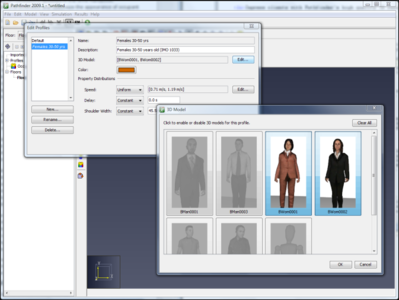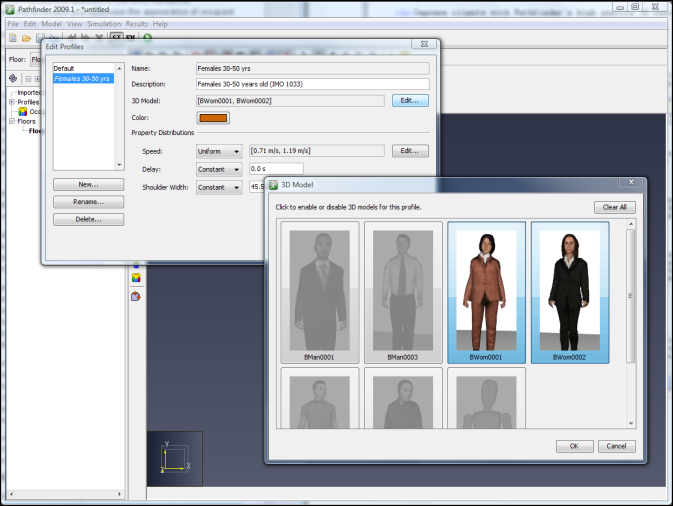Thunderhead Engineering Pathfinder v2013.1.0730 Beta (x86 / x64) | 154 MB / 155 MB
Pathfinder is an emergency egress simulator, that includes an integrated user interface and 3D results visualization. Pathfinder allows you to evaluate evacuation models more quickly and produce more realistic graphics than with other simulators. Pathfinder 2013 is now available for beta testing. This version gives the user more control over simulation geometry and movement (e.g. one way doors, door flow rate limits in steering mode), occupant-specific output data, better 3D results performance, and more.
Key Features
- Take advantage of modern agent-based simulation techniques performed in a precise, continuous 3D environment.
- Quickly create simulation models with Pathfinder’s built-in drawing features.
- Automatically import geometry from a 2D and 3D DXF files, FDS, and PyroSim.
- Use multiple simulator modes, including a new steering mode and a mode based on calculations from the SFPE Handbook.
- New “locally quickest” path selection system for more intelligent path planning.
- Elevators in addition to stairs and ramps, can be used for evacuation.
- Updated graphical interface and reduced load time in the 3D results view.
- Improved processing of imported geometry.
- Optimized performance of the simulation engine, including parallelization for multi-core CPUs.
- Enhanced realism in the movement behaviors of the individual occupants.
- New behavior scripting for adding additional movement goals prior to exit.
- New 3D occupant models to choose from, including a fire fighter model.
- Fine tune occupant characteristics and customize the appearance of occupant groups.
- Impress clients with Pathfinder’s high-quality 3D results.
- View detailed charts of room occupancy and door usage.
Since much of the time spent creating evacuation models is often devoted to describing the relevant geometry, Pathfinder includes several powerful features that are specifically designed to save time and avoid duplicate work. Existing DXF, FDS, or PyroSim files can be quickly converted into evacuation models using Pathfinder’s innovative floor extraction tool. Evacuation models that exactly match imported geometry can be created with just one click. Alternately, built-in drawing tools are available to create simulation geometry from scratch or with the aid of floor plan images.
Working with doors and stairs is also a streamlined process in Pathfinder. Graphical tools make it possible to quickly add or modify doors and stairways while carefully controlling the exact location and extent of each element.
Several options are available to add occupants to a simulation model. Using graphical tools, occupants can be added either individually or using a bounding box. Alternately, an approach based on room selection is available that can be used to add occupants to a single room or the entire model.
Individual occupants can be assigned specific properties or you can manage these properties using a powerful profile system. Each occupant belongs to a profile that controls speed, initial delay, size, and appearance. Profiles allow each of these characteristics to be constant or generated at simulation time based on uniform or normal distributions. Occupants can also be assigned to use specific exits to help simulate varying levels of familiarity with a building.
Movement Model
Pathfinder uses agent-based artificial intelligence. Each occupant has individual traits, goals, and perceptions. This allows groups of occupants to organize themselves into natural flow patterns. As a result, occupant motion looks smooth and realistic.
Rather than modeling occupants on a grid or as particles in a flow field, Pathfinder moves occupants in continuous 3D space. At each time step, every agent examines the surrounding environment and takes action based on their own conditions and goals.
In his 1987 paper, Flocks, Herds, and Schools: A distributed Behavioral Model, Craig Reynolds introduced the concept of steering behaviors. He showed that by combining three behaviors (collision avoidance, velocity matching, and flock centering) it was possible to efficiently simulate the movement of a flock of birds in real time – a feat that was otherwise computationally unmanageable.
The movement technique used in Pathfinder, inverse steering, is a variant on this original steering technique that allows agents to evaluate the cost of moving in a particular direction. At each time step, agents move in the direction that minimizes the overall cost.
Pathfinder also includes an alternate movement model based on equations from the SFPE Engineering Guide on Human Behavior in Fire. Occupant motion follows the velocity profiles given by SFPE, while flow through doors is controlled by the SPFE flow assumptions. In this mode, Pathfinder reproduces a first-order hand calculation using the SFPE assumptions. This allows you to quickly evaluate a model using these widely-known movement assumptions, even for large, complex buildings.
Pathfinder is subject to an ongoing validation process based on current and emerging movement research. To verify that individual elements of the simulator are functioning properly, simulation results are routinely compared with hand calculations. To validate the overall behavior of the simulator, real evacuation scenarios are recreated in Pathfinder and the results are compared with data gathered by independent researchers. In addition, comparisons with other evacuation simulators illustrate how Pathfinder performs relative to other modeling approaches.
Visualization
Pathfinder will impress clients with high-quality human models, movement trails, floor layouts, and other powerful 3D visualization techniques. Dynamic level-of-detail and view culling make it possible to view the motion of thousands of occupants in real time. Pathfinder records high-resolution screen images and movies, allowing you to view results on any computer.
Pathfinder output also includes quantitative time history data for door flow rates, and room-based occupant counts. 2D plots of time history output can be immediately viewed within Pathfinder.
New Features:
- Door flow rates can now be explicitly limited in steering mode.
- Added optional occupant-specific output and a summary file for all occupants’ exit time, active time, and jam time.
- Added a Find option to the Edit menu to search for occupants, rooms, and other simulation objects by name.
- Added support for AutoCAD 2013 DWG and DXF files.
- Additional control over doors is now available. Doors can be set to permit only 1-way flow and can be scripted to open and close at specific times.
- Speed modifiers can now be set on rooms, stairs, and ramps. This makes it possible to model moving walkways and escalators as well as slow down movement in specific areas.
- In the wayfinding algorithm, the variables used to estimate path now accommodate custom, occupant-specific weights on certain parameters (e.g. queue time, travel time, and global travel time). For more information, please review the Pathfinder Technical Reference.
- Occupants can be customized to avoid stairs and to walk (vs stand) on escalators.
- Occupant acceleration has been slowed down (from 0.5 seconds to full speed down to 1.1 seconds to full speed) . This change makes steering mode defaults more closely resemble measured data. For more information, please review the Verification and Validation document.
- Added new 3D models for first responders, children, elderly, medical personnel, and additional cultures.
- Improved the performance of 3D Results on multi-core machines and with graphics cards that support shaders.
- In the 3D Results, it is now possible to view the navigation mesh and imported geometry simultaneously.
- Improved the camera movement model in the results view for models that span large areas (stadiums, city blocks, etc).
- Simulations can now be started, initially paused, in debug mode to immediately see how the simulation is running.
- Documentation is now accessible via Pathfinder’s Help menu.
- Collisions are no longer supported in SFPE mode. Pathfinder 2013 will issue a warning when loading models from prior versions that used SFPE mode with collisions, change the simulator mode to steering, and enable door flow rate limits.
- When using the SFPE mode, maximum door flow rates will now be calculated from the density of the entering room by default. Previously, the default was to always use the maximum specific flow.
- The wayfinding algorithm has been updated to take into account observed door flow rates instead of using a calculated flow rate.
- The installer now organizes Pathfinder’s Windows Start Menu footprint to work with the Windows 8 Start Screen while still working with previous versions of Windows.
- Updated the bundled Java VM to version 1.6.0_45.
- [Simulator] In models with mixed occupant sizes, occupants will no longer become stuck after coming close to certain mesh boundaries.
- [User Interface] Room usage for elevators is now reported correctly.
- [User Interface] Undo now works properly after making an edit to an occupant profile in the profile dialog.
- [Simulator] Occupants no longer enter an elevator unintentionally and become stuck in the elevator as it is picking up other occupants.
- [Simulator] Fixed bug where occupants may wait for an elevator and the elevator would never pick them up.
- [3D Results] Fixed bug where an elevator shaft may appear too tall.
- [User Interface] Splitting a room now properly maintains opacity.
- [Simulator] Occupants with a radius larger than .5 m can now properly call elevators.
- [Simulator] Fixed a bug that would cause the simulation to hang if a room has doors on all sides.
- [3D Results] Fixed a bug that could cause strange triangles to appear.
- [Simulator] Occupants now properly utilize divided stairs when they are included in a stairwell.
- [Simulator] Fixed a bug that caused door usage to be artificially high in some cases.
- [Simulator] Fixed a bug that would cause a simulation to hang if a waypoint was created on a room boundary.
- [User Interface] Fixed a bug where selection might be incorrect when trying to select through a gap created by floor filtering.
- [Simulator] In SFPE mode, door flow rates are no longer limited to 1/dt (this would only be noticeable with very large doors).
- [Simulator] In SFPE mode, if several occupants arrive at a door at the same time, they will now exit in the same order every time the simulation is run.
- [User Interface] Fixed a bug where certain DWGs would appear empty when imported.
- [User Interface] Fixed a bug where Pathfinder could crash when creating an elevator.
- [User Interface] Added validation to the floor height field that disallows floor heights of zero, which would cause Floors with the label, “Floor NaN m” to be created, leading to crashes during some operations.
- [User Interface] When copying/moving occupant groups with the “Randomize” option enabled, the new occupants are now properly randomized.
- [User Interface] Fixed a crash that would occur when copying/moving a behavior that contains both “Goto Waypoint” and “Wait” actions.
- [User Interface] The “Set Z…” action now always appears correctly in the right-click menu.
- [User Interface] Copy/move will now properly copy behaviors and assign them to new occupants when both occupants and the geometry their behaviors reference are in the selection.
- [Simulator] Occupants will no longer try to use elevators with multiple doors as hallways to pass to another room, which would sometimes lead to occupants becoming stuck.
- [User Interface] Floor properties can now be edited when an empty floor is selected.
- [Simulator] Occupants will now fill elevators to nominal load nearly every time.
- [Simulator] Elevator doors will now remain open on a pickup floor as long as the elevator has room and an occupant nearby is actively trying to enter the elevator.
- [Simulator] Fixed a bug where occupants could either travel straight up or down off of the navigation mesh, sometimes without returning.
- [User Interface] Fixed a bug where the floor extractor tool would leave the progress dialog open after finishing.
- [3D Results] Fixed a bug where using the scroll wheel outside the 3D view would cause the 3D view to zoom.
- [User Interface] Fixed a bug where occupants would appear to be unlit when viewed as people on computers with AMD graphics cards.



